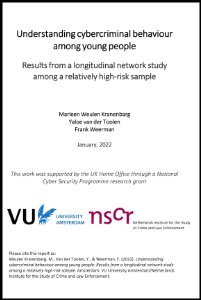Understanding cybercriminal behaviour among young people: Results from a longitudinal network study among a relatively high-risk sample
By Marleen Weulen Kranenbarg, Yaloe van der Toolen, Frank Weerman.
This report aims to increase our insight into the explanation of cyber-delinquency among juveniles. We examined which individual characteristics and environmental factors are related to different types of cybercrime, with a specific focus on the importance of peer relationships. We used a longitudinal research design (three waves of data collection) among a substantial sample of Dutch youths in secondary or tertiary education (with ages between 12 and 25), who were following ICT programmes, tracks, or courses. These students were chosen because they are considered to be at an elevated risk of committing cybercrime. We used questionnaires to collect self-report data on a large variety of cyber-offences, and on characteristics of both offline and online peers. We distinguished between cyber-dependent offending (i.e. offences requiring the use of online means) and cyber-enabled offending (i.e. offences existing in the offline world, but that can also be conducted online). We also included questions about common traditional types of offending. In addition, we asked the respondents about various individual characteristics and environmental factors and we collected detailed social network data on the respondents’ school friends. Our methods (for details, see Chapter 3) addressed various important limitations in previous research on cyberdelinquency (see Chapter 2).
Amsterdam: VU University Amsterdam/Netherlands Institute for the Study of Crime and Law Enforcement, 2022. 107p.


